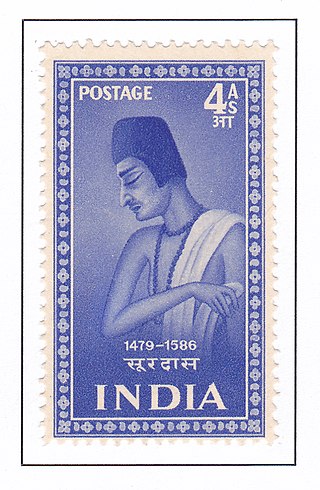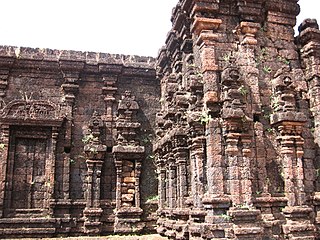
Surdas was a 16th-century blind Hindu devotional poet and singer, who was known for his works written in praise of the deity Krishna. He was a Vaishnava devotee of Krishna, and he was also a revered poet and singer. His compositions captured his devotion towards Krishna. Most of his poems were written in the Braj language, while some were also written in other dialects of medieval Hindi, like Awadhi.

Guruvayurappan also rendered as Guruvayoorappan, is a form of Vishnu worshipped mainly in Kerala, India. He is the presiding deity of the Guruvayur Temple, who is worshipped as Krishna in his child form, also known as Guruvayur Unnikkannan. The temple is located in the town of Guruvayur, Thrissur, Kerala, which is named after the deity itself.

The ChottanikkaraDevi Temple is a temple dedicated to the Hindu mother goddess Bhagavati Lakshmi. She is believed to be residing in Chottanikkara (Mahalakshmi) along with her Husband Maha Vishnu. The main deity is also considered as Lakshmi Narayana according to the temple legend. The temple is Classified one among the 108 Abhimana Kshethram of Vaishnavate tradition. The temple is located at Chottanikkara, a southern suburb of the city of Kochi in Ernakulam district, in the state of Kerala, India and is one of the most popular temples in the state. The temple is also known for conducting exorcism.

The Rajarajeshwara temple is a Shiva temple located in Taliparamba in Kannur district of Kerala State of India. The temple is regarded as one of the existing 108 ancient Shiva Temples of ancient Kerala. It also has a prominent place amongst the numerous Shiva temples in South India. It had the tallest shikhara amongst the temples of its time. The Rajarajeshwara temple has a top of about 90 tonnes. If any problem is encountered in the other temples of South India, devotees seek a solution in this temple through a prashnam, a traditional method of astrological decision-making. The prashnam is conducted on a peedha outside the temple.

The Panachikkadu Temple or Panachikkad Saraswathi Temple, also known as the Dakshina Mookambika Saraswathy Temple, is a Hindu temple dedicated to the goddess Saraswati. The temple is located in the southern region of the Indian Peninsula, in Panachikkad in Kottayam District, Kerala, India. It is one of the most prominent Saraswati temples for devotees in Kerala. But, the main deity of the temple is Lord Vishnu, who was installed long before Goddess Saraswati. Still the temple is known as Saraswati temple, due to the popularity of the Goddess. There are sub-shrines for Lord Shiva, Lord Ganapathi, Lord Ayyappan, Snake deities and Panachikkattu Yakshi inside the temple.

Ulloor S. Parameswara Iyer, born Sambasivan but popularly known as Ulloor, was an Indian poet of Malayalam literature and a historian. He was one of the modern triumvirate poets of Kerala in the first half of the 20th century, along with Kumaran Asan and Vallathol Narayana Menon. Umakeralam, a mahakavya, and Kerala Sahitya Charitram, a comprehensive history of the Malayalam language are two of his most important works.

The Vilwadrinatha Temple is a Hindu temple in Thiruvilwamala, a town in the city of Thrissur, Kerala, India. The principal deities are Rama, the seventh incarnation of the god Vishnu, and his brother, Lakshmana. It figures among the Abhimana Kshetrams in Vaishnavite traditions. This is one of the four major Rama temples in Kerala — the other three are in Thriprayar, Kadavallur, and Thiruvangad. The temple houses an idol of Lakshmana, which is rare in India. Vilwadrinatha Temple is located in the centre of the community of Thiruvilwamala, atop a 100-foot-high hillock. Visible from the temple is Bharathappuzha, the second-largest river in Kerala, which flows past the temple's northern side from around 3 kilometres away.

Mazhuvannur Maha Siva Kshethram is an ancient Hindu Temple at Tharuvana in Wayanad district of the Indian state of Kerala. The presiding deity is Lord Shiva; other deities are Arayil Bhagavathy, Shree Durga, Nandhi, Lord Ayyappa and Lord Ganapathi. This temple is situated on the highest peak in the areas of Karingari, Paliyana, and Tharuvana. Daily poojas (prayers) were performed there from ancient times. Mazhuvannur Thekke Illam family members have been involved in leading pooja for many centuries.

The Sreevallabha Temple is a highly orthodox Hindu temple dedicated to Sreevallabha, a form of Vishnu. It is located in the citty of Thiruvalla, in India.

Sri Vasudevapuram Temple is one of three ancient temples (Maha-Kshetram) on the Southern bank of holy river Bharathapuzha. It sits east of the other two, Maha-Shiva Temple and Brahma temple. These temples along with the famous Thirunavaya Maha-Vishnu temple across the river form the trilogy in Sanatana Dharma). Tavanur is called Muvaankara (മൂവ്വാങ്കര). Brahma, Vishnu, and Shiva are the presiding deities, so it was initially known as Muvalankara, and then Muvaankara. Vasudevapuram Tavanur is situated in the middle of a wooded area resembling that of Sabarimala.

Kerala Varma, most commonly known as Mahakavi Pandalam Kerala Varma, was an Indian poet, scholar, and publisher. He was born in Pandalam, and belonged to the Pandalam Royal Family. He wrote two mahakavyas, more than a hundred narrative poems, translations, and children's poetry. He is widely regarded as the author of the first complete mahakavya in Malayalam. He was the owner and Chief Editor of Kavana Kaumudi, the first Malayalam periodical, which was also the first to introduce special issues in Malayalam.
Naduvil Madhom is one of the ancient South Indian madhoms that propagate Advaita or Non dualism. It is located at Thrissur in Kerala. The history of the Madhom can be traced to 9th century AD. So the four disciples of Sankara founded four madhoms nearby. Sureśvara founded Naduvil Madhom, Padmapada Thekke Madhom, Hastamalaka Idayil Madhom, and Totakacharya Vadakke Madhom. Sri Suresvaracharya appointed Vilvamangalathu Swamiyar as the first Mooppil Swamiyar (head) of Naduvil Madhom.

Sree Valayanad Devi Temple dedicated to Bhagavathy, is situated in Valayanad near Kozhikode in North Kerala, India.

Thuravoor is a gram panchayat in the Pattanakkad Block of Cherthala Taluk of the Alappuzha District, State of Kerala, India. It comes under Aroor Assembly constituency. Thuravoor lies under Kochi UA in future. A four lane(six lane is progressing) National Highway 66 passes through the village, which along with a railway station gives it excellent connectivity with the remainder of the state. Thuravoor is famous for the Narasimha Swamy temple which is dedicated to the fourth incarnation (avatara) of Vishnu, the Narasimha. The temple has two main deities, the Vadakkanappan and the Tekkanappan, which is rare among the temples of Kerala. The new 6 lane elevated highway is from thuravoor to aroor. It is the largest 6 lane elevated highway in the country. Thuravoor is a rapid developing town. It is lies in Aroor Assembly constituency. Thuravoor Kumbalangi road is a main road parallel to NH 66. Thuravoor is the major entry to Kochi city.

Karthyayani Devi Temple, Cherthala is a famous Hindu temple located at Cherthala. Iratti and Thadi are the famous vazhipadu, Cherthala pooram is the second famous pooram in Kerala. Kalabham, in familywise, can be held on there, kalabham is a famous vazhipadu.

Thirupalkadal Sreekrishna Temple is one of the oldest Hindu temples dedicated to the Hindu God Vishnu, located in the village Keezhperoor, Chirayinkeezhu Taluk, Thiruvananthapuram in Kerala, India. The central icon is a four-armed standing Vishnu carrying the conch Panchajanya, the discus Sudarshana Chakra, the mace Kaumodaki and a lotus with a holy basil garland. The principal deity, Krishna was the family deity of Ay Family, who ruled over the place during the Sangam period. The kingdom and the family later came to be known as Venad Keezhperoor Swaroopam. It is believed that Kulashekhara Alvar, considered the seventh in the line of the twelve Alvars, renovated this temple. While it is not mentioned in the 108 Divya Desams, it does find mentioned in the list of Abhimana Kshetrams, as well as in many texts and legends. The legends of this temple are closely intertwined with that of the empires and kingdoms that ruled region called Tamilakam and especially the state presently known as Kerala. The history of this temple is closely intertwined with the Chera and Chola Empires and the Kingdoms of Venad and Travancore.
Kaviyoor is a village located in Thiruvalla Sub-District & Taluk In Pathanamthitta district of Kerala State,India, situated on the western bank of the Manimala River.It Is Located Adjoining Thiruvalla Municipal Town.

Sree Krishna Swami Temple is a Hindu temple situated at the heart of Thodupuzha town in Idukki district in the Indian state of Kerala. It is located on the banks of Thodupuzhayar, a tributary of river Muvattupuzha. Lord Krishna presides there in the form of Navaneetha Krishna who holds butter in his right pam. The tantric rights of the temple is held by the Aramallur Kavanattu Mana. The Poojas are conducted by two mutts named as 'Padinjare mutt' and 'Thuruthel mutt'.

Tirunettur Mahadeva Temple is located at Vyttila village in Ernakulam district. The temple has two main deities, Sri Parameswara and Maha Vishnu. Deities having separate temple complex; Lord Sri Parameswara in the form of Sri Rudra and Maha Vishnu in the form of Vaikundeswara. Both deities are facing east. It is believed that Shiva temple is one of the 108 Shiva temples of Kerala and is installed by sage Parasurama dedicated to Lord Shiva.
Peruvanam is a historical area of Brahmin settlement in central Kerala. In Kerala Sanskrit literature, the name "Peruvanam" is often Sanskritized as Puruvana meaning the forest where a sage named Puru lived and meditated. The name "Perumanam" is also used instead of Peruvanam.

















